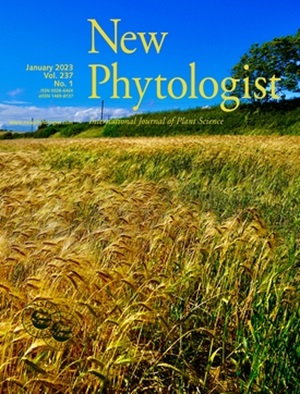Genome sequence of the wild species, Spinacia tetrandra, including a phased sequence of the extensive sex-linked region, revealing partial degeneration in evolutionary strata with unusual properties
IF 8.3
1区 生物学
Q1 PLANT SCIENCES
引用次数: 0
Abstract
- Genetic degeneration is a striking feature of Y chromosomes, often involving losses of many genes carried on the X chromosome. However, the time course of gene losses remains unclear. Sex chromosomes of plants evolved more recently than animals' highly degenerated ones, making them ideal for studying degeneration timing.
- To investigate Spinacia sex chromosome evolution and the time course of degeneration, we compared genome sequences of cultivated Spinacia oleracea, with a small Y-linked region on Chr4, with its two wild relatives.
- In spinach and its closest relative Spinacia turkestanica, the Y duplication region (YDR) introduced a male-determining factor into Chr4's low-recombining pericentromeric region. In other words, a turnover event occurred in these species' recent common ancestor. The homologous Chr4 of the more distantly related S. tetrandra has a c. 133 Mb completely sex-linked and partially degenerated region, possibly reflecting the ancestral state.
- Sequence divergence analysis suggests that two ‘evolutionary strata’ evolved shortly before the two Spinacia lineages split. Consistent with the turnover hypothesis, the YDR of the other two Spinacia species is not within the S. tetrandra older stratum. We discuss the unexpected findings in S. tetrandra that genetic degeneration, genomic rearrangements, and repetitive sequence density are all greatest in the younger stratum.
野生物种Spinacia tetrandra的基因组序列,包括广泛的性别连锁区域的阶段性序列,揭示了进化层的部分退化,具有不寻常的特性
遗传变性是Y染色体的一个显著特征,通常涉及X染色体上携带的许多基因的丢失。然而,基因丢失的时间进程仍不清楚。植物的性染色体比动物的性染色体进化得更晚,这使它们成为研究退化时间的理想选择。为了研究菠菜性染色体的进化和退化的时间过程,我们比较了在Chr4上有一个小Y连锁区域的栽培菠菜与它的两个野生近缘种的基因组序列。在菠菜及其近亲土耳其菠菜中,Y重复区域(YDR)将一个雄性决定因子引入Chr4的低重组中心点周围区域。换句话说,在这些物种最近的共同祖先中发生了一次更替事件。远亲紫杉的同源Chr4有一个约133 Mb的完全性别连锁和部分退化区域,可能反映了其祖先状态。序列分化分析表明,两个“进化层”在两个Spinacia谱系分裂之前不久就进化了。与周转假说一致的是,另外两种Spinacia的YDR不在S. tetrandra较老的地层中。我们讨论了在四分草中意想不到的发现,遗传退化、基因组重排和重复序列密度在年轻地层中都是最大的。
本文章由计算机程序翻译,如有差异,请以英文原文为准。
求助全文
约1分钟内获得全文
求助全文
来源期刊

New Phytologist
生物-植物科学
自引率
5.30%
发文量
728
期刊介绍:
New Phytologist is an international electronic journal published 24 times a year. It is owned by the New Phytologist Foundation, a non-profit-making charitable organization dedicated to promoting plant science. The journal publishes excellent, novel, rigorous, and timely research and scholarship in plant science and its applications. The articles cover topics in five sections: Physiology & Development, Environment, Interaction, Evolution, and Transformative Plant Biotechnology. These sections encompass intracellular processes, global environmental change, and encourage cross-disciplinary approaches. The journal recognizes the use of techniques from molecular and cell biology, functional genomics, modeling, and system-based approaches in plant science. Abstracting and Indexing Information for New Phytologist includes Academic Search, AgBiotech News & Information, Agroforestry Abstracts, Biochemistry & Biophysics Citation Index, Botanical Pesticides, CAB Abstracts®, Environment Index, Global Health, and Plant Breeding Abstracts, and others.
 求助内容:
求助内容: 应助结果提醒方式:
应助结果提醒方式:


